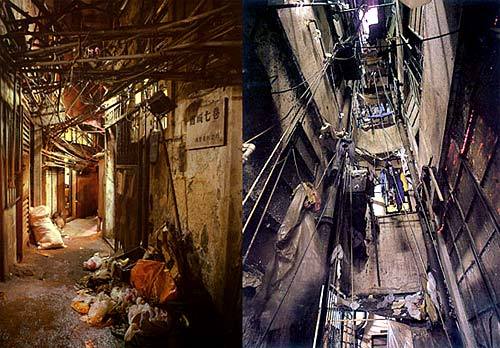The Kowloon Walled City park is a beautiful, green, serene park with waterfalls and fountains right at the edge of Hong Kong city, China. It is difficult to imagine that the park was once this.
 Refugees from the Communist China settled here, so did Hong Kong's organized crime syndicate, the Triads. ''Driven from mainland China, the Triads set up shop and start living like kings, while Hong Kong’s upper crust comes in for the sex, drugs and gambling.'' says Coilhouse Magazine + Blog Over time, 500 buildings of uniform height, each 12 to 14 stories high, were built on an area approximately 200m X 150m so close together that no light could penetrate the city. Its nickname was Hak Nam--the City of Darkness and it was home to over 35,000 inhabitants making it one of the most densely populated places in the world.
Refugees from the Communist China settled here, so did Hong Kong's organized crime syndicate, the Triads. ''Driven from mainland China, the Triads set up shop and start living like kings, while Hong Kong’s upper crust comes in for the sex, drugs and gambling.'' says Coilhouse Magazine + Blog Over time, 500 buildings of uniform height, each 12 to 14 stories high, were built on an area approximately 200m X 150m so close together that no light could penetrate the city. Its nickname was Hak Nam--the City of Darkness and it was home to over 35,000 inhabitants making it one of the most densely populated places in the world. "The health authorities kept away. So the City just developed its own legion of ad-hoc clinics and dental surgeons. In the absence of telephone and utilities companies, the City’s inhabitants just by-wired their own electricity and connections. The same nick-it-yourself approach applied to plumbing and water. As a result, a tangled network of pipes and wiring dripped and hissed above the city’s dark, dank walkways. Cheap amenities for the residents, and, considering the extremely limited access, either in or out of the compound — a potentially catastrophic fire-hazard. " (Darran Anderson, FLOTSAM & JETSAM, 5/19/2009)
"The health authorities kept away. So the City just developed its own legion of ad-hoc clinics and dental surgeons. In the absence of telephone and utilities companies, the City’s inhabitants just by-wired their own electricity and connections. The same nick-it-yourself approach applied to plumbing and water. As a result, a tangled network of pipes and wiring dripped and hissed above the city’s dark, dank walkways. Cheap amenities for the residents, and, considering the extremely limited access, either in or out of the compound — a potentially catastrophic fire-hazard. " (Darran Anderson, FLOTSAM & JETSAM, 5/19/2009)
Before the walled city was demolished, photographers and journalists were allowed to wander in it freely and these pictures taken by Greg Girard and Ian Lambot are the reason for this post. For more pictures of the daily life in this city visit the website http://www.architonic.com/ntsht/-harmonious-anarchy-revisiting-hak-nam-hong-kong-s-slum-city/7000463


No comments:
Post a Comment